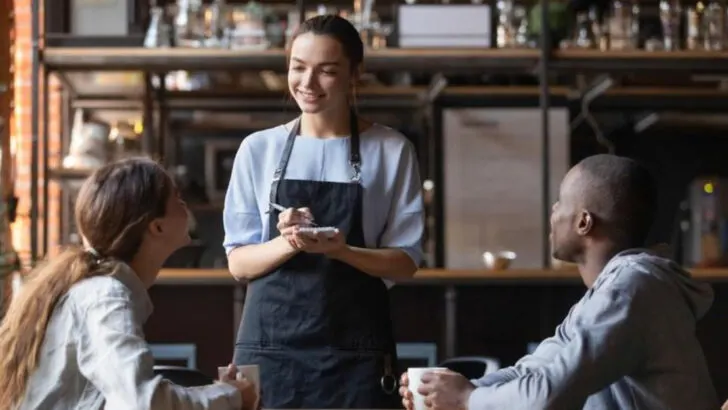The moment you sit down at a restaurant, the clock starts ticking—and your waiter is already taking notes. From the way you glance at the menu to how quickly you set down your phone, these tiny details reveal more than you think. To a trained server, it’s like reading a book where the first page tells them everything about what kind of guest you’ll be. Are you decisive or indecisive? Relaxed or already impatient? A big tipper or someone they’ll need to chase down at the end? Within seconds, your waiter has a pretty good idea. It’s not about judgment—it’s about survival. A good server knows that catching these cues early can make the difference between smooth sailing and a stormy shift. And once you know what they’re looking for, you might never sit at a restaurant table the same way again.
Your mood
Upon entering a restaurant, your mood is one of the first things waiters assess. Are you cheerful, rushed, or perhaps a bit tense? This understanding allows them to tailor their service, ensuring a pleasant experience. A smile or a frown sets the stage for interaction.
Emotion tells a story, and waiters are quick to read yours. A joyful presence might invite a more engaging service, while a reserved demeanor might call for a quieter approach.
With keen eyes, waiters adjust to the emotional climate, ensuring you’re at ease from the get-go.
How you treat the host or other staff
The way you interact with hosts and staff is a telling sign of your demeanor. Kindness and rudeness leave lasting impressions, and waiters notice them right away.
Your approach to the staff reflects on the entire dining experience. A warm greeting or a curt response can indicate how smooth or challenging the service might be.
Waiters promptly adapt to these cues. Their service style will mirror your attitude, hoping to match the ambiance you subconsciously create with your behavior.
Who’s in charge at the table
In any group, there’s usually a leader—the one who takes charge. Waiters quickly spot this person, often the first to order or make decisions for the table.
By identifying the decision maker, waiters streamline the service, ensuring that orders and preferences align with the group’s needs.
This swift recognition helps in tailoring the dining experience, as they focus on pleasing the central figure who guides the meal’s progress. Such dynamics unfold within seconds, guiding the waiter’s approach.
Whether you’ve been here before
Regular customers often exude a sense of ease, skipping menus or greeting staff by name. Waiters notice these signs, indicating familiarity and comfort with the establishment.
New visitors might ask more questions, exploring the menu with curiosity. Such behaviors help waiters adjust their approach, offering guidance or stepping back as needed.
This initial assessment allows for a tailored experience, recognizing who needs assistance and who feels right at home. Familiar faces get warm welcomes, while newcomers receive attentive introductions.
Your urgency level
Time is of the essence, and your urgency level is a crucial aspect waiters detect almost immediately. A quick glance at your watch or a whispered “we’re in a hurry” sends clear signals.
Waiters adapt their service pace accordingly, ensuring your needs are met promptly. This attentiveness helps in crafting a seamless dining experience, respecting your time constraints.
Whether it’s a bustling lunch hour or a leisurely dinner, understanding your urgency guarantees satisfaction. Such insights are gleaned in moments, shaping the rhythm of your meal.
Your tipping vibe
Without diving into stereotypes, waiters often gauge tipping tendencies based on subtle cues. Clothing, demeanor, and initial comments can hint at generosity or frugality.
These discerning looks into your “tipping vibe” help waiters manage expectations. Of course, every customer is unique, and these impressions are merely guides.
Through these observations, waiters fine-tune their level of service. The goal is a harmonious experience, where both parties leave satisfied, and financial appreciations align with the effort provided.
If you’re celebrating something
Celebrations bring an unmistakable energy. Whether it’s balloons, gifts, or an exuberant mood, waiters quickly pick up on special occasions.
These festive signals prompt them to offer personalized touches, like a surprise dessert or a congratulatory mention. The atmosphere becomes one of shared joy, with waiters enhancing the celebratory spirit.
Within seconds, they recognize the importance of your day, ensuring it’s marked with memorable gestures. Such intuitive service adds to the delight, making your occasion truly special.
How much attention you want
Body language speaks volumes, revealing how much interaction you desire. Some guests love engaging, while others prefer solitude.
Your posture, eye contact, and even the strategic placement of phones signal your preference. Waiters adeptly read these signs, fine-tuning their approach to match your comfort level.
With this quick assessment, they either engage in lively conversation or provide a more subdued service. The goal is to honor your space, ensuring a dining experience that feels just right.
If you’re drinking alcohol
Ordering alcohol often hints at a more relaxed, leisurely meal. Waiters notice this choice, adjusting their pace and perhaps offering pairing suggestions.
The decision to indulge in cocktails or wine can transform the dining experience, extending the time and enhancing the enjoyment.
Whether it’s a celebratory toast or a calming glass, the presence of alcohol shapes the atmosphere. Within moments, your order guides the service, ensuring the meal aligns with your leisurely or festive mood.
How much you’re willing to spend
Your spending comfort is often reflected in your ordering pattern. Do you scan the drink menu first or inquire about specials? Each choice offers clues.
Waiters observe these habits, aligning their service with your budget preferences. Whether opting for a lavish spread or a modest meal, your signs guide the financial dance.
This instinctive reading allows waiters to propose suitable options, ensuring satisfaction without overstepping boundaries. Your choices provide a roadmap, swiftly guiding the dining experience in harmony with your wallet.
Dietary preferences or restrictions
Dietary needs shape the dining journey. Early inquiries about gluten, vegan options, or other restrictions signal the need for attentive care.
Waiters pick up on these cues swiftly, ensuring menu items align with your needs. This understanding fosters trust, allowing guests to enjoy their meals without worry.
Dedicated attention to dietary preferences adds a layer of comfort, turning potential challenges into seamless experiences. From the first question, waiters work to accommodate, making every bite enjoyable and safe.
If you’re likely to leave a review
Today’s diners often document their experiences. Waiters spot potential reviewers through phone cameras and attentive gazes at décor.
These behaviors signal the likelihood of online feedback, shaping the service provided. A meticulous approach ensures satisfaction, knowing your experience might influence others.
From that first snap, waiters strive to impress, adding unique touches to the service. This awareness of modern dining habits reflects a commitment to quality, anticipating that your words might echo beyond the meal.

